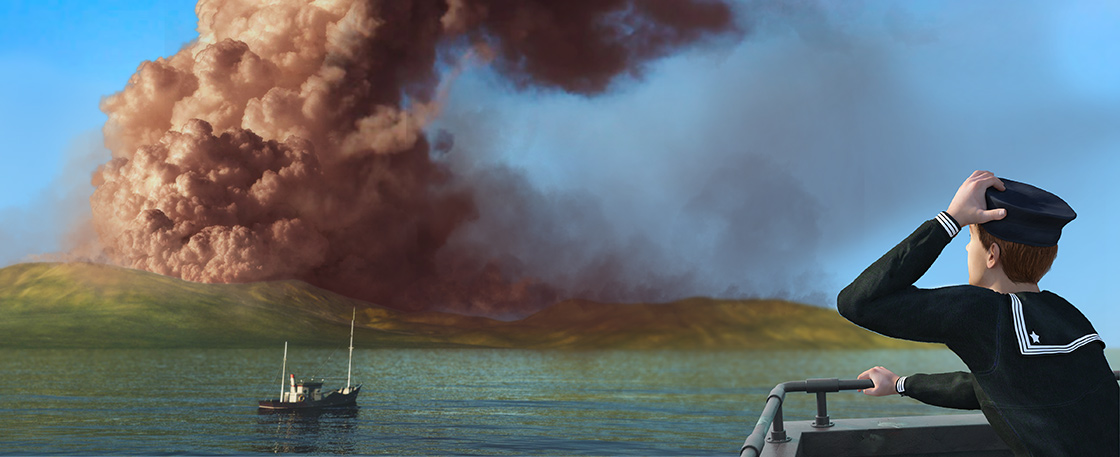Noble Driscoll
When 13-year-old Noble Driscoll woke up, he found himself in a pile of rubble near what used to be his school.
He did not know what had happened, but his mind was filled with terrifying images of smoke and fire.
He stood up and looked around at the charred brick and ash.
Where were his friends? Where was his family? Noble wondered if he was the last person alive.
December 6, 1917, dawned cold and clear in Halifax and Dartmouth, two seaside towns in Nova Scotia, Canada, separated by a narrow harbor. That morning, a fine, low mist hung over the water.
By 8 a.m., the two towns were buzzing with activity. Soft smoke curled from chimneys as mothers served up steaming bowls of oatmeal. Children gathered their schoolbooks, and fathers pulled on their coats and headed off to work.
In the northern Halifax neighborhood of Richmond, where Noble lived, horse-drawn wagons clattered down the streets. Factories churned out flour, beer, metalworks, and other goods. A tram rumbled along the waterfront, where sturdy-looking men carried cargo onto giant ships docked in the harbor. From his backyard, Noble had an amazing view of the Narrows, the aptly named narrowest section of Halifax Harbor.
Noble was fascinated by the vessels that passed in and out of the harbor. Most belonged to the military—minesweepers, submarines, and convoys that carried troops, weapons, and supplies to the war in Europe.
World War I had been raging since 1914. Many countries were involved. On one side, the major players included Great Britain, Canada (then a colony of Great Britain), France, Russia, and the United States. On the other side were Germany, Austria-Hungary (one country at the time), and the Ottoman Empire (which included modern-day Turkey).
Across Europe, gruesome battles were being fought, but this violence was thousands of miles from Halifax and Dartmouth. Noble must have felt safe in his tight-knit harborside neighborhood. In a few minutes, this would change.
A terrible accident was about to happen. Two ships—the Mont-Blanc and the Imo—were on a deadly collision course. Soon, Noble’s neighborhood would be obliterated and thousands would be dead.
Thirteen-year-old Noble Driscoll lay in a pile of rubble near what used to be his school. He did not know what had happened, but his mind was filled with scary images of smoke and fire.
He stood up and looked around at the charred brick and ash.
Where were his friends? Where was his family? Noble wondered if he was the last person alive.
December 6, 1917, had dawned cold and clear in Halifax and Dartmouth. These two seaside towns in Nova Scotia, Canada, were separated by a narrow harbor.
By 8 a.m., the two towns were busy. Mothers served up steaming bowls of porridge. Children gathered their schoolbooks. Fathers headed off to work. In the northern Halifax neighborhood of Richmond, where Noble lived, horse-drawn wagons clattered down the streets. Factories made flour, beer, metalworks, and other goods. A tram rumbled along the waterfront, where men carried cargo onto ships docked in the harbor.
From his backyard, Noble had a great view of the Narrows, the aptly named narrowest section of Halifax Harbor. Noble, a curious kid with dark hair and a wide smile, was fascinated by the vessels that passed in and out of the harbor. Most belonged to the military—minesweepers, submarines, huge convoys that carried troops, weapons, and supplies to Europe.
Since 1914, World War I had been raging in Europe. Many countries were involved. On one side, the major players included Great Britain, Canada (then a colony of Great Britain), France, Russia, and the United States. On the other side were Germany, Austria-Hungary (one country at the time), and the Ottoman Empire (including modern-day Turkey).
Gruesome battles were happening in Europe, but this violence was thousands of miles from Halifax and Dartmouth. Noble must have felt safe in his neighborhood.
But in a few minutes, this would change.
A terrible accident was about to happen. Two ships—the Mont-Blanc and the Imo—would soon collide. Noble’s neighborhood would be destroyed, and thousands of people would be dead.


